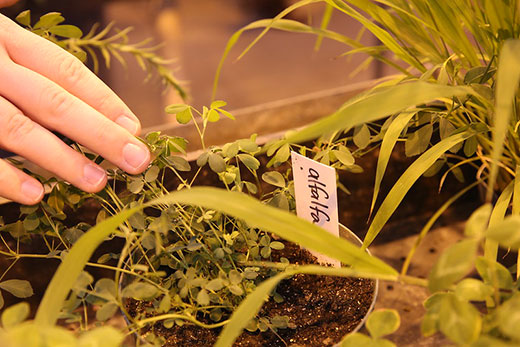
As weather warms, producers should be scouting alfalfa for signs of the alfalfa weevil, said K-State crop entomologist Jeff Whitworth. | Download this photo.
K-State crop entomologist: Be on the lookout for alfalfa weevil
Whitworth suggests that farmers start scouting their fields now
March 28, 2022
By Shelby Varner, K-State Research and Extension news service
MANHATTAN, Kan. – Kansas State University crop entomologist Jeff Whitworth said now is the time for farmers to be checking their field for the alfalfa weevil, which is considered the number one alfalfa pest.
“The adults come into the alfalfa fields in late summer, early fall and they start laying eggs in the stems of the alfalfa,” Whitworth said.
Eggs will hatch after about 300 growing degree days, a physiological measurement of temperature. That puts the newly hatched weevils in farmer’s field about now.
Alfalfa weevils leave behind tiny holes – about the size of a pin prick – in the leaves of alfalfa plants. According to Whitworth, those holes have started to show up on plants, indicating that they are starting to hatch.
As it gets warmer, more eggs will begin to hatch. “You need to get out and start scouting,” Whitworth said.
Whitworth recommends that producers wait until there is a 30-50% infestation of alfalfa weevils in a field before deciding to spray. To test the infestation level, pick stems and then vigorously shake them into a white bucket to count the number of larvae that fall off.
Whitworth shared how to calculate the infestation level. If a producer shakes 10 stems into the bucket and there are six larvae, there is a 60% infestation level. If a producer shakes 10 stems but only counts 2 larvae, then there is a 20% infestation level and should be checked within the next 4-5 days, depending on temperatures.
“Don’t go out there and spray too early,” Whitworth said. “These insecticides only last 10-14 days.”
Whitworth recommends checking the weather forecast before treating for weevils. “Anytime the temperature gets down into the mid-20s, the young larvae will be killed,” Whitworth said.
If rain is forecast in the coming 3-4 days, Whitworth suggests holding off on spraying.
More information is available at local extension offices in Kansas.

